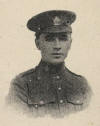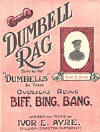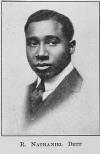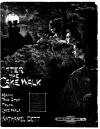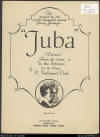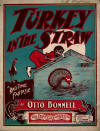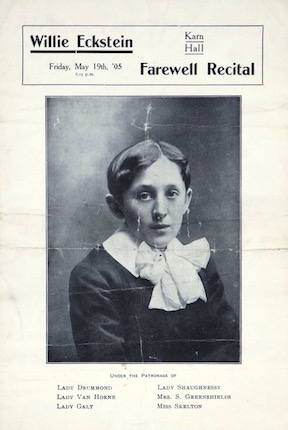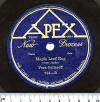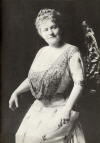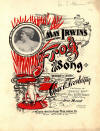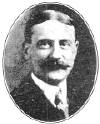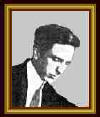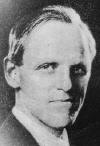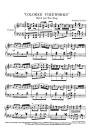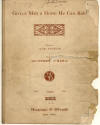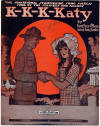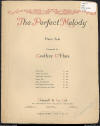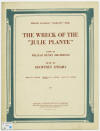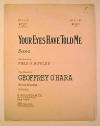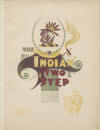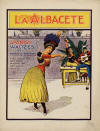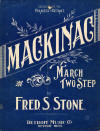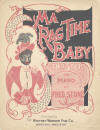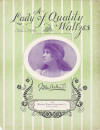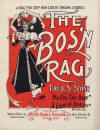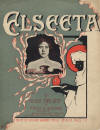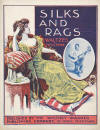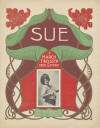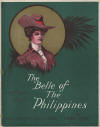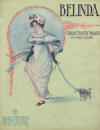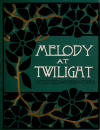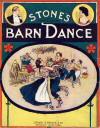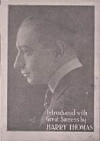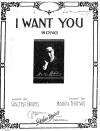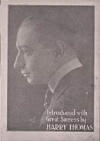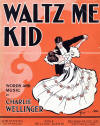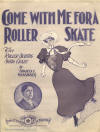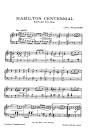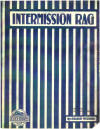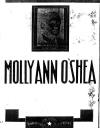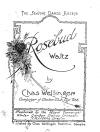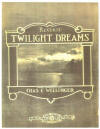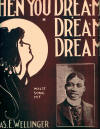|
Ragtime Music in Canada
Chapter 2: Early Canadian Ragtime Personalities and their Music
By Ted Tjaden [return to Table of Contents] [go to Chapter 3] There are a number of excellent biographies of the major American ragtime composers, including biographies about Scott Joplin (Berlin 2016), James Scott (DeVeaux and Kenney 1992) and other works on American rags and their composers (Blesh and Janis 1966, for example). The number of Canadian ragtime composers, however, compared to the number of American ragtime composers, is much smaller; as a result, there is relatively little in the ragtime literature on Canadian composers of ragtime music. Set out below (in alphabetical order, by surname) is brief mention of some of the more well known Canadian or Canadian resident ragtime composers and personalities:
Jack Ayre, a pianist in Toronto at silent movie theatres, was chosen to be the pianist for "The Dumbells," a unit in the Canadian army during World War I that entertained the troops. Ayre composed the band's theme song called The Dumbell Rag (see below), which sold over 10,000 pieces of sheet music, according to the article by Kallmann and Moogk. The Dumbells performed for troops in Europe, and after the war, they re-organized and toured (as civilians) and performed through to the 1930's.
Canada can claim R Nathaniel Dett as one of her citizens, despite his moving to the United States with his family when he was 11 years old for the rest of his life. Although Dett is known primarily for his compositions of classical music and spirituals, his three earliest known compositions were in the ragtime mode:
Inspiration Waltzes (1903): In the typical fashion of a romantic, Dett describes in the introduction to this piece his "inspiration" for it: "I awoke one night at midnight and heard, as in a dream, the melodies of this Waltz played over and over, until I again fell asleep. Next morning I found it was still fresh in my memory. I created the Introduction and some other parts to give the whole completeness, but the main themes were truly 'Inspirations' or, to put it more poetically were truly 'dictated' by the Muse." In addition, Dett also composed the following compositions that show his continuing evolution towards classical music influences:
In the introduction to In the Bottoms below, Dett describes the piece as a suite of five numbers "giving pictures of moods or scenes peculiar to Negro life in the river bottoms of the Southern sections of North America." One of those five suites is a moderately syncopated dance entitled Juba and is arguably the most well-known suites:
Dett, whose mother was Canadian, was born in Drummondville, Ontario (later incorporated into Niagara Falls, Ontario) and showed promise on the piano as a young boy and was given piano lessons. During the time he composed the three ragtime-related pieces above, Dett was an organist at a church in Niagara Falls. He later studied at the Oliver Willis Halstead Conservatory in Lockport, New York from 1901 to 1903 and then at Oberlin College (Ohio) from 1903 to 1908, where he was the first African-American to earn a Bachelor of Music degree with a major in composition and the piano. He later obtained a Master of Music degree in 1938 from the Eastman School of Music in Rochester, New York. After the publication of his early more ragtime-influenced pieces listed above, and after attending music school, Dett's compositions took on a much more classical tone, incorporating Negro spirituals and other ethnic elements. Dett's music falls with the sphere of romanticism, with highly lyrical and thematic moods. In addition to composing, Dett spent most of his working life teaching at various music faculties in the United States and touring and performing his music (including tours to Canada and to Europe). His other major works include Enchantment: A Romantic Suite on an Original Program (1922), Cinnamon Grove: A Suite for the Piano (1928), Tropic Winter: Suite for the Piano (1938) and Eight Bible Vignettes (1941 ~ 1943). During
the latter part of his life, Dett struck up a
friendship with musician Percy Grainger (composer,
of among other pieces, In
Dahomey: Cakewalk Smasher). The Sibley Music Library at the
Eastman School of Music at the
University of Rochester has an extensive R. Nathaniel Dett collection. It remains unclear whether the ragtime music of Scott Joplin influenced Dett or whether Joplin himself knew of Dett, especially given Joplin's proclivity to be taken seriously as a composer. Much of the literature is silent on this point, with there being no mention of Dett in either They All Played Ragtime (Blesh and Janish 1966) and That American Rag (Jasen and Jones 2000). Edward Berlin does mention Dett in Ragtime: A Musical and Cultural History (Berlin 1980:107) in the context of musical rhythms found in musical sources of early ragtime. Given that Dett was driven in the early 1900's to write ragtime-related pieces, it is reasonable to assume that he knew of Scott Joplin during his career, given the general popularity of ragtime music that spread throughout the North East at that time. Dett himself, in moving towards more classical compositions, was perhaps trying to avoid stereotyped ragtime sounds. In a note to In the Bottoms, Dett refers to the common rhythmic figure found in ragtime music as being a "frequent occurrence in the music of the ante-bellum folk-dances" with "its marked individuality" causing "it to be much misused for purposes of caricature." Simpson (1993:11) describes Dett's "shame" when being exposed to Dvorak's incorporation of Negro and Indian musical heritages into his music when "the naive young Dett revealed embarrassment that musically his race was identified only with the current and frivolous ragtime style." Simpson later notes, however, that later on, "while a student at Oberlin College, Dett fortunately developed a broader, more cheerful perspective of the larger Negro idiom" but even as late as 1918 Simpson notes (1993:12) that Dett commented on the attitude of a majority of the black race in an interview carried by Musical America:
However, it is less certain whether Joplin knew of Dett and his music. The possibility exists that perhaps he did not, given the regional differences that "served as barriers to a shared culture" and that affirmed "the existence of diverse experiences within the African American community in the United States" at that time (Curtis 1994:188). Since Dett's classical compositions came towards the end of Joplin's life, and given the state of communications in those days, it is entirely possible that Joplin died, dreaming of his own classical ambitions with the publication of his opera Treemonisha without knowing of the classical publications of R. Nathaniel Dett. A more detailed analysis of Dett's life and his (classical) music is provided by Simpson (1993). Dett died of a heart attack on October 2, 1943, but his legacy lives on in Canada through The Nathaniel Dett Chorale, described on their website as "Canada's first professional choral group dedicated to Afrocentric music of all styles including classical, spiritual, gospel, jazz, folk and blues."
William Eckstein, also known as Willie, Billie or Billy Eckstein, was born to European immigrants in Pointe St. Charles, a predominantly Irish, working-class district of Montreal, one of 14 children (Gilmore 1988:25). According to Hutton (1985), Eckstein began playing at age 3, and at age12, he won a scholarship to study music at McGill University. He also studied in Europe, and after returning from Europe was "headhunted" while playing at the Canadian National Exhibition in Toronto, Ontario, and went on a very successful North American tour. On tour, he was billed as "The Boy Paderewski" since he was only 4 ft., 9 in. tall and wore a Fauntleroy suit to give the impression he was younger than he was: According to Hutton (1985), Eckstein was earning $15,000 per year while on tour (a lot in those days) but when he grew too old, the novelty of the "act" wore off and he returned home to Montreal. In Montreal, he was the resident pianist at the Strand Theatre, where he was billed as "The World's Foremost Motion Picture Interpreter" (Gilmore 1988: 17). Apparently, fans would come to the movie theatre primarily to listen to him, not necessarily to watch the movies. One of his protégés was Harry Thomas, discussed below and he also played with Vera Guilaroff, also discussed below. An advertisement
promoting a "farewell recital" on 19 May 1905 by
a young Eckstein before he left Montréal to
embark on an American and European tour included
in the programme a number of classical pieces
including pieces composed by Bach, Beethoven,
Scarlatti, Mendelssohn, as well as an
"Improvisation" on "a theme to be given by the
audience":
Eckstein, along with Harry Thomas, composed the Delirious Rag and the Perpetual Rag, with the likelihood that these compositions were never published or transcribed by them. Eckstein was the first person to record Joplin's Maple Leaf Rag as a piano solo (1923). According to Hutton (1985), Eckstein was admired by Teddy Roosevelt and Eubie Blake described Eckstein as "one of the best I ever heard." After
"talking" moving pictures arrived, Eckstein
retired from the movie theatre and played piano at
the Chateau Ste. Rose in Montreal for 20 years as
"Mr. Fingers" (Hutton 1985). Eckstein
continued to play piano until age 73, but was
forced to retire when he broke his arm. In May
1963 at an evening tribute in his honour, Eckstein
collapsed into a coma after the ceremony, never to
recover (he died several months later). For a
12-minute documentary film by Mark Borowsky, see "The Life & Times of
Willie Eckstein".
For a listing of 53 of Eckstein's
compositions (with 30 of those compositions having
their sheet music freely available online), see the entries for
Eckstein's compositions in the essay Ragtime Music in Québec
on this site.
Vera Guilaroff, although born in England, immigrated to Montreal with her family as a young child, where she studied piano. As a teenager, she played at the Regent Theatre in Montreal, substituting for Harry Thomas when he could not play and eventually replacing him when Thomas moved to Halifax. She later toured the United States with a band, returned to Montreal and worked with Eckstein on radio and in nightclubs. She also toured Europe and the Bahmas and performed on TV and composed several songs, some of which are listed below (not rags). More details of her life are set out in the entry for her in the online The Canadian Encyclopedia. Her recording of Scott Joplin's Maple Leaf Rag is amazing and shows lots of improvisation; the breakneck speed at which she plays it is breathtaking and one suspects it may have been sped-up as part of the recording process. A partial listing of compositions by Guilaroff include the following pieces:
May Irwin
was born in Whitby, Ontario,
but gained her fame on the New York stage as a
vaudevillian comedienne and singer of "coon" songs
that apparently were regarded as comical during
that era but what can now only be regarded as
offensive. One of her more famous songs was
apparently May Irwin's Bully Song,
not shown here due to its content and artwork. A
number of her songs can be found through the Sheet
Music Consortium. An example of one of her
comic songs is May Irwin's Frog Song,
the cover sheet of which is set out below.
She is also famous as being one of the first persons ever filmed in a movie kiss in the movie The Kiss. She was known to have spent time at a summer home in Canada near the Thousand Islands on the St Lawrence River and become a wealthy women as a result of her performances and investments. She died in New York City on October 22, 1938. Her Wikipedia entry is here. f)
Jéan-Baptiste
LaFrenière (23 June 1874 – 4 January
1912)
Jéan-Baptiste Lafrenière, described as the national Strauss of Canada, was born in 1874 in Maskinongé, Quebec. According to Plante (1994) Lafrenière spent most of his youth in Montreal and Louiseville where he studied piano, organ, violin, cornet, and music theory at the College St-Joseph de Berthier (1887-1892). Gilmore (1988:25) suggests that Lafrenière was the first person known to have performed ragtime in Montreal. Lafrenière was a relatively prolific composer of a number of rags, marches, waltzes and other piano instrumentals. According to Plante (1994), Lafrenière contracted tuberculosis in 1911 and was forced to subsist on the slender income earned from his music publications and he died January 4, 1912, at age 37 leaving behind a widow (Victoria Danis) and two young children. He is buried in the Côte-des-Neiges cemetery in Montreal. A number of CDs recorded by Mimi Blais include LaFrenière compositions. To view all 44 compositions by Lafrenière, see the separate essay on this website called "Ragtime in Quebec" (this essay also includes a listing of over 140 ragtime-era compositions by composers other than Lafrenière that were published in Quebec, with over 100 of these having the sheet music available for free). g) Joseph F Lamb (6 December 1887 – 3 September 1960)
Although Joseph Lamb was born in New Jersey, it is possible for Canada to claim him as a ragtime resident based on his connections here on two separate occasions:
For more on Joseph Lamb, see the separate page on this website entitled "Joseph Lamb: Ragtime's Quiet Sensation." h)
Geoffrey
O'Hara (2 February 1882 – 31 January 1966)
The article from The Virtual Gramophone: Canadian Historical Sound Recordings entitled "Geoffrey O'Hara, Composer, Singer and Lecturer (1882-1967)" accurately describes three major aspects of O'Hara's professional life: composer, singer and lecturer. Born in Chatham, Ontario, nine years after Fred S Stone (see below on Stone), O'Hara played piano as a child and wrote ragtime compositions in his early twenties, sometimes using the name "Geofrrey de Vere." A list of some of his ragtime-related compositions are below, including his compositions available online and his compositions available in print (these lists are of course partial since he apparently wrote over 500 songs). According to the entry for him in The Canadian Encyclopedia he joined Lew Dockstader's Minstrels and went on to sing light opera as a baritone at Daly's Theater in New York. Later O'Hara travelled the Lyceum and Chautauqua vaudeville circuits as a singer, lecturer, and community song leader. Apparently, he wrote two of his hit songs — "Give a Man a Horse He Can Ride" (1917) (below) and "K-K-K-Katy" (1918) (below) — while he was visiting in Kingston, Ontario. Selected Geoffrey O'Hara Compositions from the Ragtime Era
I am also trying to obtain the following piece:
Fred S Stone was a relatively prolific composer of ragtime music. I have been playing his Silks and Rags Waltz (1901) (below) for a number of years now without realizing that Stone was born in Chatham, Ontario (nine years before Geoffrey O'Hara, discussed above). The fact of his Canadian birth is not well known since the (relatively few) references to him in the ragtime literature is as an "African-American" composer. Blesh and Janis (1966:104-05) provide some basic information on Fred S Stone regarding his early rags and his involvement in Detroit as a bandleader:
Blesh and Janis (1966:104-05) also describe Stone's efforts in unionizing musicians in Detroit:
Jasen and Jones (2000:320) give 1912 as the date that Stone died; however, Blesh and Janis (1966:105) state that "Fred S Stone died in the middle 1930's." Editorial note: The Ragtime Ephemeralist has an article on Fred S Stone and Harry Guy by Nancy Bostick and Arthur LaBrew that I am trying to obtain. Once I do, I will update more information on Fred S Stone. Select Compositions by Fred S Stone (in chronological order)
Harry Thomas was born Reginald Thomas Broughton in Bristol England but immigrated to Montreal, Canada, when he was 19 years old (Gilmore 1989: 280). Apparently, Thomas had no formal musical training and was self-taught but "studied" under Willie Eckstein and would play at the Strand Theatre in Eckstein's absence:
In the fall of 1916, Harry Thomas went to Chicago to record piano rolls for QRS Company and then on to New York to record Delirious Rag and Perpetual Rag for Metro-Art and Universal (Gilmore 1988: 17). Later that year, he returned to New York to record for Victor Talking Machine a 78 rpm with Delirious Rag on one side and A Classical Spasm on the other side, also manufactured in Montreal by the Berliner Gramophone Company (see above for his recording of A Classical Spasm). These recordings, according to Gilmore (1989:281) made Thomas the first musician resident in Canada to record ragtime. At around this time, Thomas became the pianist at the Regent Theatre in Montreal, with Vera Guilaroff as his substitute starting when she was as young as age 12. After 3 years of this, Thomas moved to Halifax and Guilaroff took over his piano duties at the Regent Theatre. While in Halifax, Hutton (1985) suggests that Thomas was somewhat of a celebrity, driving a very noticeable 1923 Graham-Paige roadster "that seemed to be half a block long, with gaudy upholstery and a dinky little rumble seat." In the 1920s, with the arrival of talking motion pictures, Thomas found himself without work and returned to Montreal, but his career did not survive:
According to Hutton (1985), Thomas died in poverty on 1941 and was buried in a Montreal cemetery, Cote des Neige Cemetery, but the wooden stake marking his grave was later removed for non-payment of fees. Eckstein was one of the few mourners at his funeral. Selected Harry Thomas Compositions
I am also looking for the following composition by Harry Thomas:
k) Charles
E Wellinger (b Ottawa ca 1888, d
England ca 1943)
There is very little information about Charles Wellinger other than a brief paragraph about him in the entry for "ragtime" in The Canadian Encyclopedia. From that entry we learn that he was born in Ottawa, Canada, in 1888 and died in England in 1943. We know from the music he composed, both his music available online (below) and his music available in print (below), that a number of his earlier pieces for piano and voice were published with HH Sparks in Toronto circa 1905-1907 and that a number of other pieces were self-published by him in Hamilton, Ontario, circa 1913-1920 with another piece, Intermission Rag, published in Chicago, Illinois, in 1919. The entry
in the Encyclopedia of Music in Canada suggests
that he worked with IW Lomas at the opera house in
Hamilton and probably with Lomas' Royal Connaught
Winter Garden Dance Orchestra. He wrote and
published several songs, waltzes, and rags. The Encyclopedia
also suggests that his piece, That
Captivating Rag (1914), is his most
popular piece. Selected
Compositions by Charles Wellinger
Additional compositions by Charles Wellinger: I am looking to obtain copies of the following additional compositions by Wellinger; when I do, I will digitize them and add them to the table above.
In the next chapter, I discuss Canadian ragtime publishers and record producers. [return to Table of Contents] [continue to Chapter 3] [top]
|
||||||||||||||||||||||||||||||||||||||||||||||||||||||||||||||||||||||||||||||||||||||||||||||||||||||||||||||||||||||||||||||||||||||||||||||||||||||||||
|
This site created by Ted Tjaden. Page last updated: January 2026.
|
